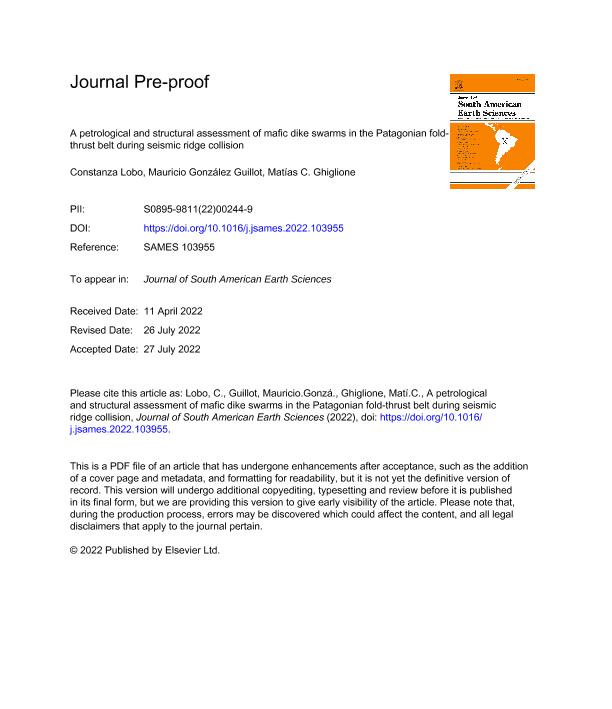Mostrar el registro sencillo del ítem
dc.contributor.author
Lobo, Constanza

dc.contributor.author
Gonzalez Guillot, Mauricio Alberto

dc.contributor.author
Ghiglione, Matias

dc.date.available
2023-09-04T12:20:40Z
dc.date.issued
2022-11
dc.identifier.citation
Lobo, Constanza; Gonzalez Guillot, Mauricio Alberto; Ghiglione, Matias; A petrological and structural assessment of mafic dike swarms in the Patagonian fold-thrust belt during seismic ridge collision; Pergamon-Elsevier Science Ltd; Journal of South American Earth Sciences; 119; 103955; 11-2022; 1-46
dc.identifier.issn
0895-9811
dc.identifier.uri
http://hdl.handle.net/11336/210308
dc.description.abstract
Between Viedma and San Martín lakes, in an area of 1200 km2 that partly covers the Southern Patagonian cordillera and the Miocene-Pliocene extra-Andean basaltic plateaus, mafic dike swarms crop out which have not been studied previously. As a result of mapping on satellite images and in the field more than 1500 dikes were identified. The dikes crop out in a zone between rear-arc calc-alkaline intrusions to the west and tholeiitic-alkaline plateau basalts to the east, within the internal and external fold-thrust belt. In order to understand the genetic relationship between the dikes, other igneous units in the region and the structures of the Andean orogeny, a petrological study (including petrography and geochemistry) and a structural analysis of the dike orientations were carried out. The dikes were emplaced close to the surface (<1 km). Three predominant compositions were recognized: basalts, which predominate, followed by tephrites and andesites, the latter restricted to a single sector. We propose preliminarily the following correlations: (i) the dikes of tephritic composition with the Río Carbón Essexite (Eocene), (ii) the andesites with the Chaltén Adakite (Miocene) and (iii) the basaltic dikes with the Pliocene basaltic plateaus. All these units are related in the literature to different stages of ridge subduction and slab window development. The dikes present variable, but not random, preferential orientations, with no relation with composition. Our analysis suggests that dike emplacement was controlled by previous anisotropies in a heterogeneous and very shallow crust. The anisotropy in the internal fold-thrust belt was achieved mainly during Eocene and/or Late Cretaceous contraction, whereas that in the external fold-thrust belt was developed during a less significant Miocene compressive event, thus resulting in a more homogeneous dike orientation. The vertical disposition of the dikes indicates horizontal stretching, as previously proposed for the last stages of Andean growth.
dc.format
application/pdf
dc.language.iso
eng
dc.publisher
Pergamon-Elsevier Science Ltd

dc.rights
info:eu-repo/semantics/openAccess
dc.rights.uri
https://creativecommons.org/licenses/by-nc-nd/2.5/ar/
dc.subject
FOLD-THRUST BELT
dc.subject
MAFIC DIKES
dc.subject
SLAB WINDOW
dc.subject
SOUTHERN PATAGONIA
dc.subject.classification
Geología

dc.subject.classification
Ciencias de la Tierra y relacionadas con el Medio Ambiente

dc.subject.classification
CIENCIAS NATURALES Y EXACTAS

dc.title
A petrological and structural assessment of mafic dike swarms in the Patagonian fold-thrust belt during seismic ridge collision
dc.type
info:eu-repo/semantics/article
dc.type
info:ar-repo/semantics/artículo
dc.type
info:eu-repo/semantics/publishedVersion
dc.date.updated
2023-06-30T15:19:51Z
dc.journal.volume
119
dc.journal.number
103955
dc.journal.pagination
1-46
dc.journal.pais
Países Bajos

dc.journal.ciudad
Amsterdam
dc.description.fil
Fil: Lobo, Constanza. Consejo Nacional de Investigaciones Científicas y Técnicas. Centro Austral de Investigaciones Científicas; Argentina
dc.description.fil
Fil: Gonzalez Guillot, Mauricio Alberto. Universidad Nacional de Tierra del Fuego. Instituto de Ciencias Polares, Recursos Naturales y Ambiente; Argentina. Consejo Nacional de Investigaciones Científicas y Técnicas. Centro Austral de Investigaciones Científicas; Argentina
dc.description.fil
Fil: Ghiglione, Matias. Consejo Nacional de Investigaciones Científicas y Técnicas. Oficina de Coordinación Administrativa Ciudad Universitaria. Instituto de Estudios Andinos "Don Pablo Groeber". Universidad de Buenos Aires. Facultad de Ciencias Exactas y Naturales. Instituto de Estudios Andinos "Don Pablo Groeber"; Argentina
dc.journal.title
Journal of South American Earth Sciences

dc.relation.alternativeid
info:eu-repo/semantics/altIdentifier/url/https://www.sciencedirect.com/science/article/pii/S0895981122002449
dc.relation.alternativeid
info:eu-repo/semantics/altIdentifier/doi/http://dx.doi.org/10.1016/j.jsames.2022.103955
Archivos asociados
